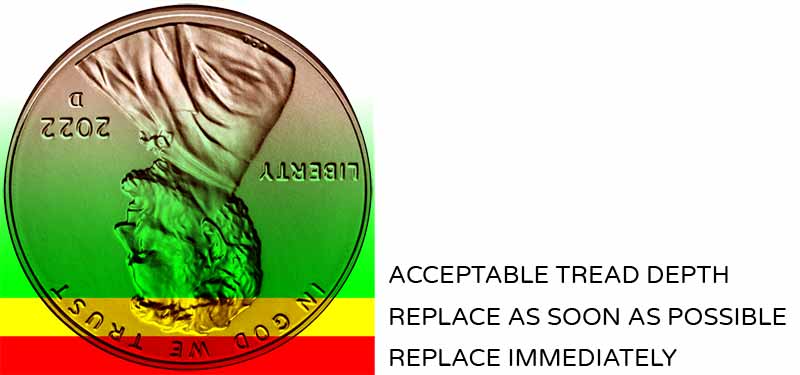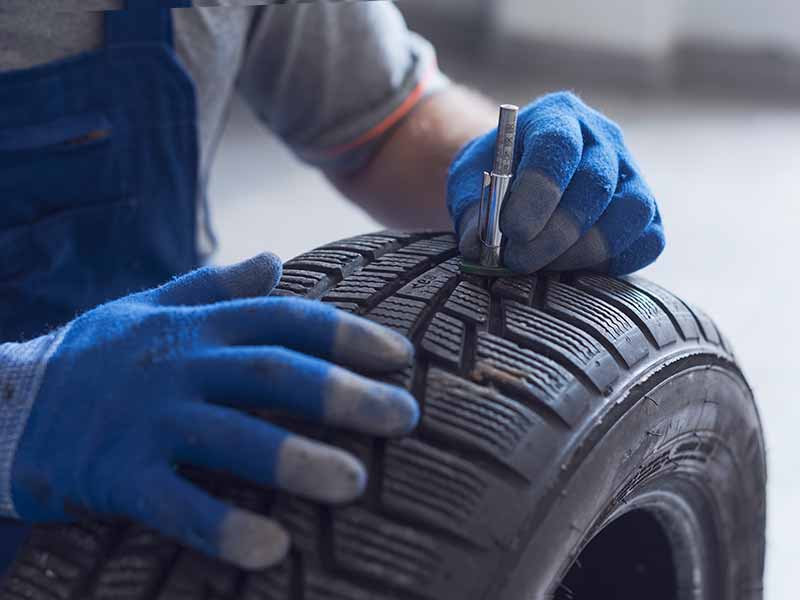Tire maintenance and safety is something most of us don’t give enough attention. It really doesn’t take much effort to make sure that your tires are well maintained, but most of us don’t know the simple actions that will keep us safe and ensure their tires last as long as possible – saving us money.
While we go in-depth covering all aspects of tire care, this article will give you the basics you need to ensure that your tires are in excellent condition for as long as possible.
If you have specific questions about tires be sure and search our site for answers.
Tire Safety Checklist
• Check tire pressures match those listed in the driver’s door jamb
• Inspect tires for uneven wear and damage
• Ensure tread depth is 4/32″ or greater
• Rotate tires every 5,000 miles
• Balance and align every 10,000 miles
• Check your spare tire for low pressure or damage
Air Pressure
The single most important maintenance tip you can take away from this article is to maintain your tire air pressure accurately and regularly.
Air pressure can cause extreme premature tire wear quickly. This is true for under-inflated tires as well as over-inflated tires.

Under-inflation will cause the tires to wear on the outer edge of the tire tread while over-inflation will cause the tread to wear in the center due to the tire ballooning outward.
Under-inflated tires will put a lot of stress on the sidewalls of your tires as well. The air pressure is suppose to be supporting the weight of your car or truck, but without enough air pressure the sidewalls bear that burden.
When the sidewalls of your tire have to carry more weight than they were designed to carry they flex a lot as the tire spins. This heats the sidewall up and can cause rapid failure and a catastrophic blowout.
I remember as a kid flexing a paperclip back and forth until it broke. It would heat up and snap after just a few quick bends. Bending slowly prevented it from snapping. The same is true with your tires.
Think about how many tires your tire rotates a minute as your driving at 40 miles per hour and how many times the sidewall flexes beyond the point it’s designed to when under inflated. SNAP!
Vehicles come equipped with tire pressure monitoring systems (TPMS) these days, but you shouldn’t count on it to let you know when you need to top up the pressures in your tires. That’s not what they’re designed to do.
The purpose of TPMS is to prevent you from driving on a flat or dangerously under-inflated tire without realizing it. As sidewall heights have become shorter it has become more difficult to know when a tire is dangerously low on air pressure.
You should check your tire pressure monthly to ensure that they are at the air pressure listed in your door jam or owner’s manual.
Making the job of tire maintenance easy is important to ensuring that you will follow through on the simple tasks when they need to be performed. I highly recommend keeping a portable tire pump in your car or truck at all times. It’s important for roadside safety, but also very handy for checking air pressure in your tires as part of your regular tire maintenance routine.
CRAFTSMAN V20 INFLATOR

The Craftsman V20 Inflator can be plugged into a standard outlet or your vehicle’s power adapter. It has an easy-to-read digital gauge display and is surprisingly quiet. You can also set it to your desired pressure and walk away because it has an auto shutoff feature.
Treadwear
Replacing your tires before they’ve lost too much tread depth to become a safety hazard is important. If you’re not occasionally checking the tread depth on your car or truck you’re hoping that someone else catches it during routine maintenance.
Tires have wear bars built into the tread pattern that indicate when they must be replaced. It’s key to understand that tire tread becomes less and less effective at doing its job as it wears down.
The depth of the grooves between the tread blocks is what moves water out from under the tire contact patch and prevents hydroplaning. By the time tires are worn down to the wear bar, they’ve lost almost all ability to remove water from the contact patch and are extremely dangerous to drive on.
Learn More About Tire Air Pressure
Uneven Treadwear Examples
Cupping
Feathering
Heel & Toe
Shoulder
You should check your tire tread depth on each tire every 6 months. This is easy to do. You can get a tire tread depth gauge if you like, but a penny will work just as well. The penny test works by inserting a penny with Abe’s head upside down next to a tread block. If you can see all of honest Abe’s head, he’s telling you it’s time to replace those tires.

If you’re using a tire depth gauge, the wear bar is all the way down at 2/32″ of depth left. You really shouldn’t be driving on tires with that small amount of tread left. If your gauge reads 4/32″ it’s time for new tires. Anything 6/32″ and above is safe to continue using.
Be sure to check across the width of the tire for wear. Uneven tire wear across the tread is normal and expected. If any portion of the tread has been worn beyond the suggested safe amount you should replace them.
Tread Depth Gauge
It’s important to periodically check your tire tread depths. You can use a coin, but if you prefer something a little more accurate and easy to read, I highly recommend a dial depth gauge.
There are plenty of inexpensive options out there but I’ve found the large round gauge easier to read and very accurate.
Rotation
Rotating your tires is important to help get the most life out of your tires. Rotation should be performed every 5,000 miles and the rotation pattern should follow that suggested by the vehicle owner’s manual.
There are various tire rotation patterns that are used in different situations, but the most common patterns are the forward cross which is used on front wheel drive vehicles, the rearward cross which is used on rear wheel drive and all wheel drive vehicles, and the x-pattern which is used on any of these drive axle configurations.
Not rotating your tires regularly will result in tires with uneven wear and will become unusable much more quickly than those that are rotated.
The tires at each corner of your vehicle come into contact with the road surface and different angles due to suspension designs that improve handling and safety.
For instance, it’s usual for rear tires to have what’s called negative camber. This means the tops of the tires tilt inward slightly and they will wear down much more quickly on the inner shoulder of the tire.
Rotating rear tires forward to the front axle that has much less negative camber will shift the contact patch more toward the center of the tire tread.
Common Tire Rotation Patterns
Forward Cross
Rearward Cross
X-Pattern
Learn More About Tire Rotation
Alignment
Ensuring your tires are aligned properly is important to have done regularly. It’s recommended that an alignment be performed approximately every 10,000 miles.
The old guidance was that an alignment should be performed every other oil change, which would be every 6,000 miles. Fortunately, advances in engine design and synthetic lubrication have moved oil changes from 3,000 mile intervals to often as long as 10,000 miles.
While 6,000 miles would still be great, my recommendation is that you have an alignment performed every 10,000 miles. This will coincide with every other tire rotation and with each oil change for many people. Taking care of multiple vehicle maintenance tasks at one time means that you spend less time sitting at your local mechanic and less money.
Your tires don’t usually drift out of alignment much. Suspension components will usually only fall out of alignment due to damage of some kind. This can happen due to pot holes, hitting curbs, or more serious abuse.
If you suspect you have an alignment issue due to your vehicle pulling more to one side or the other, or unusual tire wear patterns, you should consider having an alignment performed sooner.
Learn More About Wheel Alignment
Balancing
Your wheel assemblies (the wheel and tire combination) need to be balanced before being mounted onto your car or truck. Failing to have this done will result in an extremely bumpy and potentially dangerous ride.
Wheels and tires need to be very precisely balanced so that they will spin smoothly at highway speeds. Every wheel or tire will be every so slightly out of balance. Adding small weights in just the right spots will balance the wheel assembly and ensure a smooth ride.
As your tires wear down, they can begin to fall out of balance over time. It’s recommended that your tires be balanced every 10,000 miles. This lines up well with having an alignment, rotation, and oil change for many car owners.
Learn More About Tire Balancing
Spare Tire
Spare tires are often forgotten about but they should receive regular tire maintenance just like any other tire. Usually this just consists of checking the tire pressure, making sure there isn’t any obvious damage, and ensuring the tire is not more than 6 years old.
You can check the age of your tires by referring to the DOT code on the sidewall. The last 4 digits of the DOT Code are the date of manufacture. The first half of this 4 digit code is the week of manufacture and the last half is the year of manufacture.
The whole point of a spare tire is to keep you from being stranded and having to wait on a tow truck. If the tire pressure of your spare is too low and you don’t have an air pump, or the tire is damaged and it won’t hold air, what’s the point of lugging that thing around with you everywhere?
If you happen to have a full-size spare tire and a matching wheel to go with it, you should be taking advantage of rotation patterns that incorporate the spare into the mix. This will help you get the most bang for your buck out of your spare and dramatically extend the life of your tires.
Resources
Below are some links you may find helpful when learning about tires
- Tire Safety – Discount Tire Direct
- Tire Safety Checklist: What to do before your next road trip – Consumer Reports
Final Thoughts
It’s especially important to check your tire pressure and ensure your tires have enough depth in the tread groove to evacuate water before you drive long distances.
Checking the depth of your tire’s tread, for uneven tread wear, ensuring you have the recommended air pressure in your vehicle’s tires that is listed in the driver’s door jamb, and having regular wheel alignment and tire rotation performed will all go a long way toward ensuring you won’t have a flat tire or other tire failure. These simple tasks will also improve your fuel economy and help you get the most life (and money) out of your tires.






